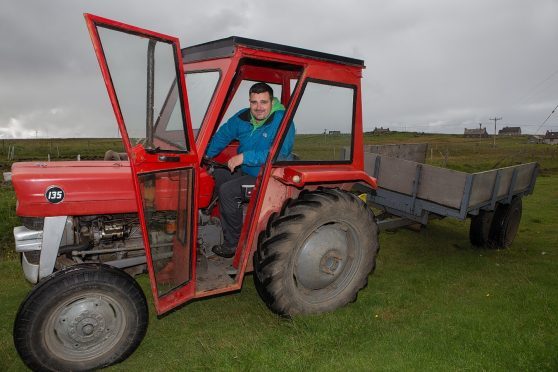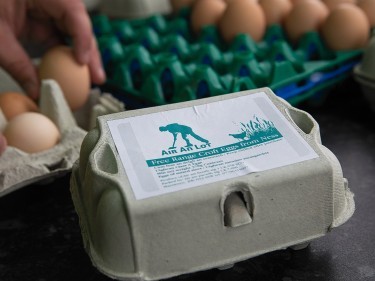The crofting sector on the Isle of Lewis is alive and kicking. In the first of a three part series Gemma Mackenzie speaks to a young crofter having a crack at egg production
Donald Macsween, or Sweeny as he is known to his friends, lives and breathes the crofting life.
And he is on a mission to fulfil his ambition of becoming a full-time crofter.
Sweeny currently works at the education department at the Western Isles Council, and is a familiar face on the sheepdog trials circuit, presenting Farpaisean Chon-Chaorach on BBC Alba.
However his real passion is crofting and last year he took the plunge and reduced his hours working at the council to give more time to the croft.
“I grew up in a crofting family – it’s what I enjoy doing,” said Sweeny, who crofts in North Dell, Ness, in the north of the island.
“Through my job I have spent the last two years encouraging young people to go down the enterprise route and do what they enjoy. I thought to myself I’m telling other people to do it and I’m not doing it myself.”
Before reducing his hours, Sweeny decided to venture into free-range egg production, and in May last year he ordered 300 hens.
“Before that I kept 40-50 hens but I couldn’t keep up with demand,” he said.
“I now keep about 350 laying hens and I have started building up my sheep numbers as well.”
In January he started selling eggs in local shops on the island, under the Air an Lot brand, which is gaelic for ‘on the croft’. A box of six eggs retails at £1.50.
The home croft, which Sweeny took on 10 years ago on his 21st birthday, consists of seven acres.
However, the land he crofts stretches to around 50 acres due to renting and sub-tenanting other crofts in the area. And he has access to just under 500 acres of common grazings land.
His sheep flock consists of around 80-90 breeding ewes, which are mainly Blackface and Cheviot.
From the sheep enterprise, he aims to sell around 10 lambs privately as meat.
On future plans, Sweeny says he wants to be able to work full-time on the croft.
“The reason I got the sub-tenancies was to get to do an Agri Environment and Climate Change Scheme (AECS), and I do croft tourism as well,” he said.
The idea for crofting tourism came from seeing the lack of knowledge about crofting amongst some youngsters on the island.
“Because I grew up on a croft, it’s almost taken for granted that you just know everything about crofting. But because of the work I was doing with schools, I realised there are lots of young people who know nothing about crofting at all,” said Sweeny.
He has been dabbling with crofting tourism for just under two years, but plans to fully launch an offering to tourists in 2016 by giving them the chance to try a ‘hands-on crofting experience’.
Speaking at the auction mart in Stornoway on a wet dreich day, surrounded by crofters more than double his age, Sweeny is critical of the government schemes to help young farmers and crofters.
“I’m 31 and I’ve been a crofter for 10 years. That means in the eyes of the government that I’m not eligible for any extra assistance,” said Sweeny.
“The game-changer is hopefully the ewe hogg scheme, but my concern is that if people abuse it and keep more than they should it could be ended.”
He said the scheme, which is formally known as the Scottish Upland Sheep Support Scheme (SUSS), would help him to build up numbers in his sheep flock.
The scheme, which is worth around 8million euros (£5.65million), was set up to provide direct support to sheep producers in remote and fragile areas of Scotland.
In order to qualify for support, the producer must have 80% or more of their land in the Basic Payment Scheme region 3, and no more than 200 hectares (495 acres) of land in region 1.
Support is available for home-bred stock females which must be kept on the claimant’s holding, or away winterings, from October 17 in the claim year to March 31 the following year.
The support is only available for animals that are less than 12 months old at the start of the retention period.
Despite the challenges with government support and this year’s weather, which Sweeny describes as being the worst he has ever seen, he remains upbeat about the future.
“My hope is that between the eggs and tourism, I will be nearer to doing full-time crofting. I’d also like to get Highland cows in the future,” he said.
“I’m trying not to have all my eggs in one basket.”

